
On 7 June 1978, the Chilean Oil tanker Cabo Tamar ran aground at San Vicente Bay, near Talcahuano, Chile, and released 12,000 tons of oil (of the 64,000 ton load). [1]

On 7 June 1978, the Chilean Oil tanker Cabo Tamar ran aground at San Vicente Bay, near Talcahuano, Chile, and released 12,000 tons of oil (of the 64,000 ton load). [1]

An oil spill is the release of a liquid petroleum hydrocarbon into the environment, especially the marine ecosystem, due to human activity, and is a form of pollution. The term is usually given to marine oil spills, where oil is released into the ocean or coastal waters, but spills may also occur on land. Oil spills may be due to releases of crude oil from tankers, offshore platforms, drilling rigs and wells, as well as spills of refined petroleum products and their by-products, heavier fuels used by large ships such as bunker fuel, or the spill of any oily refuse or waste oil.

Oriental Nicety, formerly Exxon Valdez, Exxon Mediterranean, SeaRiver Mediterranean, S/R Mediterranean, Mediterranean, and Dong Fang Ocean, was an oil tanker that gained notoriety after running aground in Prince William Sound spilling its cargo of crude oil into the sea. On March 24, 1989, while owned by the former Exxon Shipping Company, and captained by Joseph Hazelwood and First Mate James Kunkel bound for Long Beach, California, the vessel ran aground on the Bligh Reef resulting in the second largest oil spill in United States history. The size of the spill is estimated to have been 40,900 to 120,000 m3, or 257,000 to 750,000 barrels. In 1989, the Exxon Valdez oil spill was listed as the 54th largest spill in history.

An environmental disaster or ecological disaster is defined as a catastrophic event regarding the natural environment that is due to human activity. This point distinguishes environmental disasters from other disturbances such as natural disasters and intentional acts of war such as nuclear bombings.
SS Torrey Canyon was an LR2 Suezmax class oil tanker with a cargo capacity of 120,000 short tons (110,000 t) of crude oil. She ran aground off the western coast of Cornwall, England, on 18 March 1967, causing an environmental disaster. At that time she was the largest vessel ever to be wrecked.
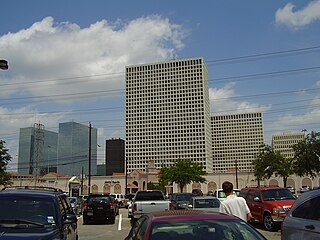
Transocean Ltd. is the world's largest offshore drilling contractor based on revenue and is based in Vernier, Switzerland. The company has offices in 20 countries, including Canada, the United States, Norway, Scotland, India, Brazil, Singapore, Indonesia, and Malaysia.

Ixtoc I was an exploratory oil well being drilled by the semi-submersible drilling rig Sedco 135 in the Bay of Campeche of the Gulf of Mexico, about 100 km (62 mi) northwest of Ciudad del Carmen, Campeche in waters 50 m (164 ft) deep. On 3 June 1979, the well suffered a blowout resulting in one of the largest oil spills in history.

A tanker is a ship designed to transport or store liquids or gases in bulk. Major types of tankship include the oil tanker, the chemical tanker, and gas carrier. Tankers also carry commodities such as vegetable oils, molasses and wine. In the United States Navy and Military Sealift Command, a tanker used to refuel other ships is called an oiler but many other navies use the terms tanker and replenishment tanker.
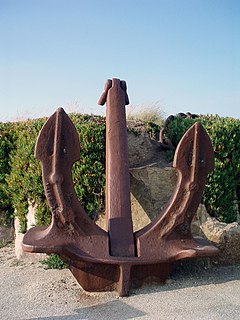
The Aegean Sea tanker oil spill was a spill that occurred on 3 December 1992 when the double-bottomed Greek-flagged oil tanker, Aegean Sea, en route to the Repsol refinery in A Coruña, Spain, suffered an accident off the Galician coast. The ship had successfully passed all required tests and revisions. The accident occurred during extreme weather conditions and affected the Galician coast resulting in ecosystem damage, as well as damage to the fishing and tourist industries in A Coruña. The captain and pilot were found to be criminally liable and the shipowner took on much of the monetary liability.

Muxía is a coastal town and municipality in the province of A Coruña in the autonomous community of Galicia in northwestern Spain. It belongs to the comarca of Fisterra. It is one of the final destinations for pilgrims on the Way of St. James after visiting the shrine of the apostle Saint James the Great in Santiago de Compostela.
Jakob Maersk was an oil tanker registered in Denmark that struck a sand bank on January 29, 1975 while entering the port of Leixões, Portugal, causing a major oil spill.
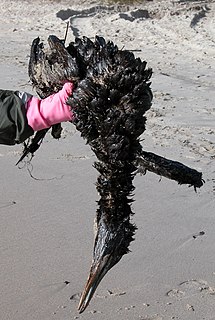
The Prestigeoil spill occurred off the coast of Galicia, Spain, caused by the sinking of the 26 year old structurally deficient oil tanker MV Prestige in November 2002, carrying 77,000 tonnes of heavy fuel oil. During a storm, it burst a tank on November 13, and French, Spanish, and Portuguese governments refused to allow the ship to dock. The vessel subsequently sank on November 19, 2002, about 210 kilometres (130 mi) from the coast of Galicia. It is estimated that it spilled 60,000 tonnes or a volume of 67,000 m3 (17.8 million US gal) of heavy fuel oil. The spill polluted thousands of kilometers of coastline and more than one thousand beaches on the Spanish, French and Portuguese coast, as well as causing great harm to the local fishing industry. The spill is the largest environmental disaster in the history of both Spain and Portugal. The amount of oil spilled was more than the Exxon Valdez incident and the toxicity considered higher, because of the higher water temperatures.

An oil tanker, also known as a petroleum tanker, is a ship designed for the bulk transport of oil or its products. There are two basic types of oil tankers: crude tankers and product tankers. Crude tankers move large quantities of unrefined crude oil from its point of extraction to refineries. Product tankers, generally much smaller, are designed to move refined products from refineries to points near consuming markets.
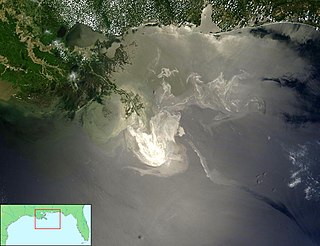
The Deepwater Horizon oil spill was an industrial disaster that began on 20 April 2010, in the Gulf of Mexico on the BP-operated Macondo Prospect, considered to be the largest marine oil spill in the history of the petroleum industry and estimated to be 8 to 31 percent larger in volume than the previous largest, the Ixtoc I oil spill, also in the Gulf of Mexico. The U.S. federal government estimated the total discharge at 4.9 million barrels. After several failed efforts to contain the flow, the well was declared sealed on 19 September 2010. Reports in early 2012 indicated that the well site was still leaking. The Deepwater Horizon oil spill is regarded as one of the largest environmental disasters in American history.

The VLCC Metula was a supertanker that was involved in an oil spill in Tierra del Fuego, Chile in 1974. The ship was a Very Large Crude Carrier (VLCC), with a length of 1,067 feet, draft of 62 feet and a deadweight ton capacity of 206,000. It was the first VLCC supertanker to be involved in a major oil spill.
Guamblin Island, also known as Socorro Island, Nuestra Señora del Socorro or Huamblin, is a Chilean island. The island is a National Park, and listed as an Important Bird Area. It is a breeding ground of the sooty shearwater.

Guimaras Strait is a strait in the Western Visayas region of the Philippines, connecting the Visayan Sea with the Panay Gulf and Sulu Sea beyond. To the north and west are Panay and Guimaras Islands, while Negros Island is to the south and east. Bacolod City is a major seaport on the strait, which also provides access to the Port of Iloilo City via the Iloilo Strait.

This page covers environmental issues in Chile.

Būtingė oil terminal is an oil terminal near the village of Būtingė in northern Lithuania. Planned, designed and implemented by Fluor Corporation, it is a part of ORLEN Lietuva. Būtingė has been in operation since July 1999, and is the first major petroleum project that Lithuania implemented after it attained independence in 1990. The facilities can accommodate crude oil exports of 8 million tons and imports to the extent of 6 to 8 million tons.
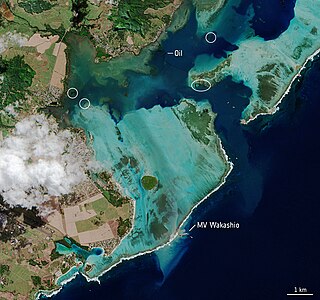
The MV Wakashio oil spill, Man-made Ecological and Economical Disaster, occurred offshore of Pointe d'Esny, south of Mauritius, close to the Marine Protected Area designated as the Second Wetland of International Importance under the ‘Ramsar Convention’ which is renowned for its remarkable coral garden and is home to more than 1,000-year old brain coral, the largest brain coral in the Indian Ocean,. After the Japanese bulk carrier Wakashio ran aground on a coral reef on 25 July 2020 at around 16:00 UTC. The ship began to leak fuel oil in the following weeks, and broke apart in mid August. Although much of the oil on board Wakashio was pumped out before she broke in half, an estimated 1,000 tonnes of oil spilled into the ocean in what was called by some scientists the worst environmental disaster ever in Mauritius. Two weeks after the incident, the Mauritian government declared the incident a national emergency.